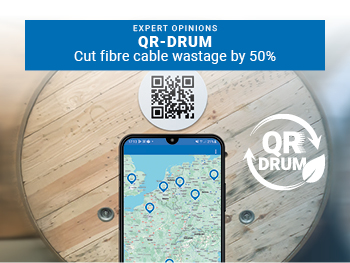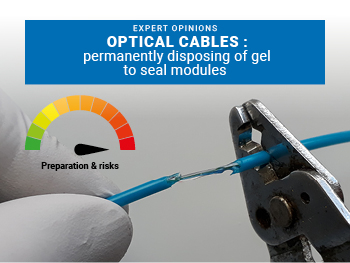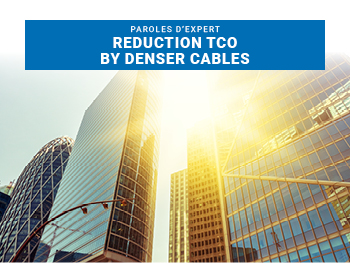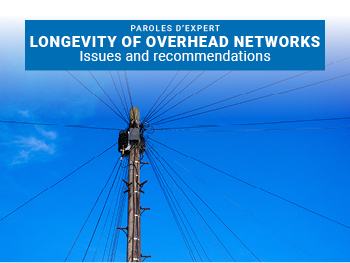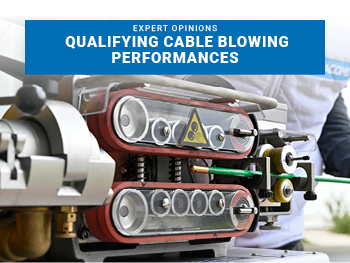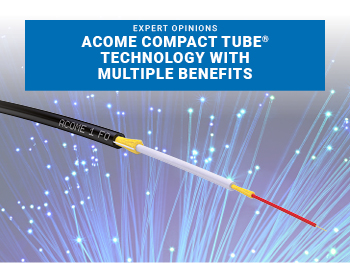Are FTTH overhead optical networks as reliable as copper networks?
For nearly a century, ACOME has been supporting the rollout of telecommunications networks. Over the last 50 years, copper telecommunications networks (50% developed by ACOME in France) have provided an extremely reliable service. In France, signal loss due to damaged passive infrastructure occurs statistically only twice in the lifetime of a copper line. Today, this network is giving way to fibre optics, with a higher speed to meet current and future challenges as well as the expectations of France’s superfast internet project.
ACOME is recognised player in overhead optical networks
ACOME has 20 years of experience and expertise in optical fibre networks, with reliability and sustainability as a source of innovation. Optical fibre is deployed in large part by using overhead infrastructures, and ACOME is a leading player in this area. The figures speak for themselves: since the start of the superfast internet project in France in February 2013, no interruption or degradation of service associated with the overhead optical fibre network has been observed despite environmental constraints, such as the very strong storms experienced by Europe in recent years.
Optical and mechnical reliability: the secrets to success
In order to ensure the robustness of fibre optic networks and optimise their service life, two major elements must be taken into account:
- Optical reliability: Ensuring that the transmission of the optical signal does not deteriorate over the lifetime of the cable
- Mechanical reliability: Ensuring that the fibre does not break during the lifetime of the cable
How can we maintain the reliability of optical transmission
The choice of fibre: a key parameter
Whatever the constraints to which the cable is exposed, the choice of optical fibre plays a very important role. In addition to the cable design, the type of fibre used determines the resilience of the network in the face of the different events it will experience over its lifetime. These events lead to bending stress on the optical fibres (micro or macro-bending).
The optical fibres of the G657A2 family are designed to reduce the sensitivity to bending. A type G652D fibre will be more sensitive to bending than a type G657A2 fibre.
Let’s look at some different examples:
The compression of the fibre optic cable (crushing, pinching of the sheath) leads to micro-bending stress on the optical fibre. Depending on the wavelengths used, this can result in an attenuation loss of 3 to 25 times greater with a G652D fibre than with a G657A2 fibre.

Example of attenuation measurements at different wavelengths for crushing stress on an optical cable
Source : SYCABEL
Another example consists of studying the effects of traction on an overhead cable moored at posts by anchor clamps (appearance of micro-bending phenomena at mooring points). In this second example, we can see, once again, the difference in behaviour between the two types of optical fibres. The weakening of the signal with the same tensile force applied to the cable is less than 0.1 dB for the G657A2 fibre and can reach 9 dB for the G652D fibre.

Measurement of the attenuation related to traction on an optical cable held by anchoring clamps.
Source : SYCABEL
Promoting G657A2 fibre to improve the reliability of optical transmission
The G657A2 fibre range, known for its lack of sensitivity to bending, considerably improves the reliability of optical transmission and robustness of the optical network with respect to its environment. Its use in quality cables is recommended and even required in certain cases: in July 2020, ARCEP published an official opinion requiring the use of this type of fibre in the FTTH shared optical local loop.
How can we maintain the mechanical reliability of the optical link?
The main reason for using a fibre that is not sensitive to bending is clearly outlined above, but it should be noted that using a fibre that is “too insensitive” could also be a risky choice. Indeed, stress may sometimes be invisible during network inspections carried out after the installation of the cable and the implementation of network components.
Stress on the fibre can then escape detection during inspections, while still having a strong impact on the service life of the optical fibre. In splicing cassettes or other coiling areas, for example, the attenuation linked to a strong bending of the optical fibre may go unnoticed or be confused with the attenuation linked to a splicing or pigtail. If the bend radius is too low, this leads to premature ageing of the fibre and its breakage in the short or medium term (from a few days to a few months).
An “overly insensitive” fibre is therefore not mechanically reliable.Bend radii of less than 4 mm have a strong impact on the life of optical fibres. A difference of one millimetre can divide the lifetime of the optical fibre by 10.
For example, with a 3 mm bend radius, the fibre will have an estimated lifetime of 100 days, while with a 2 mm bend radius, its lifetime is estimated at between 1 and 10 days. (For more information, refer to document IEC TR 62 807.)
This is why, in order to detect bend radii affecting the service life of the optical fibre, G657A2 fibres, sensitive to bends of less than 7.5 mm, are strongly recommended once again. This type of fibre makes it possible to detect extreme stress affecting the lifetime of the fibre and to intervene before the breakage or premature ageing of the optical fibre.
Discover the article about micro-bends and macro-bends in FTTH networks.
Fibre elongation: choosing the right cable to guarantee the service life
Throughout its life, an overhead optical cable faces constraints that affect its level of extension.
The first constraint is permanent topological traction: the cable is under constant tension due to its weight, the range between the posts and the sag accepted by the infrastructure manager.
In addition, there are intermittent climate constraints such as wind, ice weight or snow. Extending the optical fibre too much leads to accelerated ageing and breakage.
An overhead cable must be designed while taking into account the elongation of the optical fibre and limiting it for specific constraints. The higher the level of elongation of the fibre in the cable, the greater the risk of breaking the fibre over time. The table below shows the probability of breakage over 25 years depending on the level of elongation of the optical fibre.

Source : ITU datas.
Overhead cables are designed according to two major indicators showing the maximum tension supported by the cable while providing a framework for the elongation of the optical fibre: the MOT (Maximum Operating Tensile) which corresponds to the maximum tension supported by the cable over the long term (e.g. topological constraints or the average wind force in the deployment area) and the MAT (Maximum Allowable Tensile) which corresponds to the maximum tension supported over the short term during a one-off event (e.g. climatic constraints that cause peaks in tension).
These indicators are defined in agreement with the customer and usually, in the case of overhead use, the MOT corresponds to elongations of less than 10%* (green zone in the table), whereas the MAT corresponds to fibre elongations of 10% to 30%* (blue zone in the table). These indicators are defined in agreement with the operators of the optical network.
These are not the only parameters to be taken into account, since the design of the cable can, in turn, reduce the tension generated by the various environmental constraints.
- Diameter optimisation: The larger the cable diameter, the stronger the wind pressure. In addition, the weight of any snow or ice deposits will increase with the size of its diameter.
- Optimising the weight of the cable: The lighter the overhead cable, the lower the linear stresses and the lower the stresses at anchor points.
Thus, through dimensional optimisation and judiciously choosing the materials used, we can optimise the weight and diameter of the cable and reduce the stresses it undergoes.
Summary of key points
In order to guarantee the service life of the overhead optical network, it is necessary to take into account the optical reliability as well as the mechanical reliability of the overhead cables and the fibres they contain.
There are two major factors involved in achieving this.
Cable design
The diameter, weight and elongation management of optical fibres throughout the life of the infrastructure require perfect control of the manufacturing processes. The quality of manufacturing materials, which should comply with international standards, is also essential.
The use of optical cables based on flexible micro-modules is a key element in optimising diameter and weight to improve the reliability of telecommunications networks.
The ideal fibre choice
To choose the optimal fibre, you must opt for a compromise between:
- An optical fibre not very sensitive to bending (micro-bending and macro-bending) to preserve optical transmission with respect to external stresses;
- An optical fibre that is sufficiently sensitive to detect defects in its use that could impact its service life.

Assessment of optical and mechanical reliability according to the type of optical fibre
In accordance with ARCEP recommendations, specifically in the set of functional and technical specifications on FTTH networks outside very dense areas, the optical fibre G.657.A2 (B-657.A2 according to EN 60793-2-50, corresponding to ITU-T G.657.A2) is preferred.
